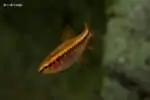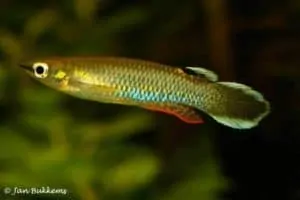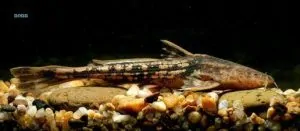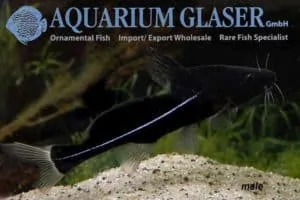Puntius titteya – Cherry Barb
Puntius titteya was first described by Deraniyagala in 1929. Over time, Barbus titteya and Capoeta titteya have appeared as synonyms. Currently, its original name, Puntius titteya, is still the official valid name for this fish species.
The common name of these fish is Cherry barb. This name is a reference to the red colouration of these fish.
Description
Cherry barbs have a distinctive dark to bright red colour. The brightness of their colouration is dependent on the mood and sex of these barbs. Male specimens of Puntius titteya display brighter colours than females which are darker. This distinction becomes especially clear when the fish are ready to mate. During this period, the males will display their red colour at their best to impress females. Even though their body is entirely red, dorsally the fish are darker coloured than on their bellies. Besides the red colour, a dark, horizontal bar runs across the body from the head of the fish until the caudal fin.
Distribution and Habitat
The Cherry Barb is found in Sri Lanka. On this island they live in waters that flow through the tropical forests. Here the fish are mainly found in shady places. Research into these rivers shows that the substrate consists of sand or mud. In addition, there is little current in these waters. They are found in the basin of the Kelani and Nilwala rivers. For example, Pethia nigrofasciata, Belontia signata and Devario malabaricus also live in this area.
Measurements by researchers showed that Cherry barbs live in their natural habitat at a water temperature ranging from 22°C to 25°C. Meanwhile, the pH of the streams varies between 5.2 and 7.1.
Diet
Puntius titteya is an omnivorous fish species. In addition to algae and detrius, these barbels also eat insects and their larvae. However, they are not very difficult fish to get to eat in the aquarium. In addition to live and frozen food, Cherry Barbs also eat flakes. However, make sure that the natural diet is mimicked. So alternate carnivore food with food for herbivores such as cucumber and algae tablets.
The aquarium
Cherry Barbs prefer an aquarium with dimmed lights. In addition, a dark substrate will enhance the colouration of the fish. Heavily planting the aquarium and placing driftwood, creates a sufficient amount of hiding places for the fish. Furthermore, placing leaves on the substrate will mimic the natural habitat of the fish.
Puntius titteya is a peaceful species and will not attack specimens of their own species or other species. However, as these barbs are schooling fish, keep them with enough specimens of their own species. This will not only make these fish less shy, but they will also display more color and more interesting behavior.
Breeding
Puntius titteya is easy to breed and they can do so in a community aquarium. However, since these fish do eat their own eggs and fry, setting up a separate breeding tank will increase the yield.
The breeding aquarium for Cherry barbs must be equipped with materials that ensure that the parents cannot eat the eggs. This can be done with many fine-leaved plants, such as Java moss. In addition, spawning mops can be placed. Another option is a base of marbles or a grid above the substrate. In addition, the light in the aquarium must be dimmed. The water should be acidic with a temperature on the high side.
When the aquarium is ready, the parents can be released. To do this, take fish that are ready for mating. Since Cherry Barbs lay eggs in nature all year round, simulating a shower during the rainy season is not necessary. They will spawn in the morning. Remove the parents immediately after the eggs have been laid.
The eggs hatch after 24 to 48 hours. After another 24 hours the fry will be swimming freely. From this moment on they eat only the smallest of food. Feed them infusoria. Artemia and microworms can be given a little later when they have already grown somewhat
Video
Author
R. Eltingh
Copyright images
John de Lange
Resources
California Academy of Sciences. (n.d.). Retrieved April 15, 2018, from Researcharchive.calacademy.org
Cruz, T. (n.d.). Puntius titteya summary page (R. B. Reyes, Ed.). Retrieved April 15, 2018, from Fishbase.org
De Silva, S. S., Schut, J., & Kortmulder, K. (1985). Reproductive biology of six Barbus species indigenous to Sri Lanka. Environmental Biology of fishes, 12(3), 201-218.
Jayaneththi, H. B. and H. G. S. Maduranga, 2004. A preliminary study on the diversity of Ichthyofauna of Kukulugala proposed forest reserve, Ratnapura district. Sri Lanka Naturalist, 6 (1&2): 17-23.
Puntius titteya – Cherry Barb (Barbus titteya, Capoeta titteya). (n.d.). Retrieved from Seriouslyfish.com













Reviews
There are no reviews yet.